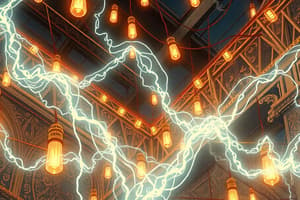Podcast
Questions and Answers
Which type of cell is rechargeable and can restore its chemical reactions?
Which type of cell is rechargeable and can restore its chemical reactions?
- Zinc-carbon cell
- Lead-acid battery (correct)
- Button cell
- Alkaline cell
Direct current (DC) allows electric charge to flow in multiple directions.
Direct current (DC) allows electric charge to flow in multiple directions.
False (B)
What is the unit used to measure electric current?
What is the unit used to measure electric current?
amperes
Electrons flow in the opposite direction to ________ current.
Electrons flow in the opposite direction to ________ current.
Match the following types of cells with their characteristics:
Match the following types of cells with their characteristics:
Flashcards
What is a primary cell?
What is a primary cell?
A primary cell is a type of battery that cannot be recharged. Once the chemical reactants are used up, the cell is permanently spent.
What is a secondary cell?
What is a secondary cell?
A secondary cell, or battery, can be recharged. The chemical reactions are reversible, allowing the battery to be restored to its initial state.
What is electric current?
What is electric current?
Electric current is the rate at which electric charge flows through a conductor. It is measured in amperes (A), where 1 ampere equals 1 coulomb of charge per second.
What is conventional current direction?
What is conventional current direction?
Signup and view all the flashcards
What is electron flow?
What is electron flow?
Signup and view all the flashcards
Study Notes
Sources of Direct Current
- Direct current (DC) is a unidirectional flow of electric charge.
- Sources of DC include various types of cells and batteries.
- These sources create a potential difference that drives the flow of electrons.
- Different sources provide different levels of voltage and current.
- The source must maintain a consistent potential difference for a constant DC.
Kinds of Cells
- Primary cells are non-rechargeable. Once the chemical reactants are used up, the cell is spent.
- Examples: zinc-carbon cells, alkaline cells.
- Secondary cells (batteries) are rechargeable. The chemical reactions are reversible and can be restored to their initial state.
- Examples: lead-acid batteries, nickel-cadmium (NiCd) batteries, lithium-ion batteries
- Rechargeable batteries store chemical energy and convert it to electrical energy. They have a longer lifespan than primary cells.
Electric Current As Rate of Flow of Electric Charge
- Electric current is the rate at which electric charge flows through a conductor.
- It is measured in amperes (A), where 1 ampere is equal to 1 coulomb of charge per second.
- Mathematically, current (I) = charge (Q) / time (t).
- Current represents the number of electrons flowing per unit time.
Direction of Current
- Conventional current direction is defined as the direction in which positive charge would flow.
- Historically, positive charge was thought to be the carrier. This standard is still used.
- Electron flow is the actual movement of negatively charged electrons.
- Electrons flow in the opposite direction to the conventional current.
- The direction of electron flow is against the direction of conventional current.
- Both conventional and electron flow concepts are valid, and the choice depends on the context.
Studying That Suits You
Use AI to generate personalized quizzes and flashcards to suit your learning preferences.




